Lessons learned by causing a false AIS MOB alert
The grins tell the story: Mission accomplished! Due to an obscure but noteworthy electrical glitch, plus oodles of embarrassingly distracted seamanship on my part, a sizable U.S. Coast Guard team spent part of a beautiful Saturday looking for an AIS man overboard alert that seemed to be associated with my boat Gizmo. Fireman Joey Jansen-Hedrick and Petty Officer 1st Class T.J. Iaci (above) were the boarding party that had to deal with an owner/operator (me) who was pretty sure they didn’t know what they were talking about. But they were politely persistent, and they were right…
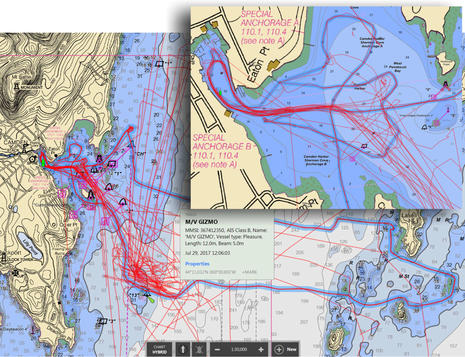 First, here’s an overview of the eventful July 29th cruise which includes a sense of all the boats that were out and about. It’s a NMEA 2000 log of received AIS tracks that was automatically collected by a Yacht Devices YDVR and later displayed as a GPX file in Coastal Explorer (and you’ll see below how it helped confirm the “incident” analysis).
First, here’s an overview of the eventful July 29th cruise which includes a sense of all the boats that were out and about. It’s a NMEA 2000 log of received AIS tracks that was automatically collected by a Yacht Devices YDVR and later displayed as a GPX file in Coastal Explorer (and you’ll see below how it helped confirm the “incident” analysis).
The highlighted Gizmo track suggests how I first motored over to the launching ramp dock on Eaton Point to pick up six friends and family, and then how we tagged along behind the 10 am classic boat parade back into the Inner Harbor, took a few gawker turns around the amazing superyacht Le Grand Bleu anchored north of town, crossed the Bay to check out seals and such, and timed our return to watch the noon Camden Classics Cup race starts. We even took pictures for the PenBay Pilot, and it was almost a complete blast of a summer Saturday excursion.
 Because I didn’t have a clue about the one event I really should have paid attention to until USCG 47228 from Rockland Station vectored in on Gizmo as I headed back to the ramp to drop off the happy guest crew. Over VHF the boat team told me they needed to board us in order to search for the source of a mysterious DSC man overboard alert, and while I picked up a mooring, they (nicely) got an assistant harbormaster to ferry over the Petty Officer and the Fireman in a small boat.
Because I didn’t have a clue about the one event I really should have paid attention to until USCG 47228 from Rockland Station vectored in on Gizmo as I headed back to the ramp to drop off the happy guest crew. Over VHF the boat team told me they needed to board us in order to search for the source of a mysterious DSC man overboard alert, and while I picked up a mooring, they (nicely) got an assistant harbormaster to ferry over the Petty Officer and the Fireman in a small boat.
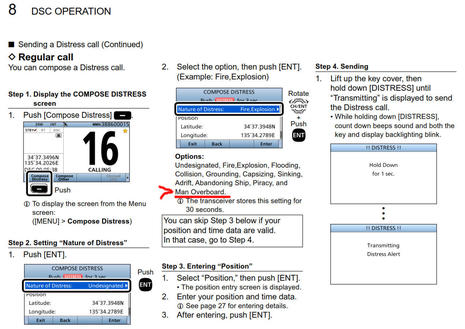 As I expected, the MMSI they were looking for did not match Gizmo’s FCC-issued vessel MMSI, which is programmed into the recently discussed Icom M605 that had been powered up throughout the trip, and into a Standard Horizon HX851 handheld that they also wanted to check (even though it had not been touched). It was at about this juncture — Officer Iaci patiently asking me about other possible radios aboard (there were), me pleading to be on my way — that I wondered if the problem was really a DSC MOB distress call, which requires several manual steps as shown in the M605 manual above. “Maybe you mean an AIS MOB distress message?” I asked.
As I expected, the MMSI they were looking for did not match Gizmo’s FCC-issued vessel MMSI, which is programmed into the recently discussed Icom M605 that had been powered up throughout the trip, and into a Standard Horizon HX851 handheld that they also wanted to check (even though it had not been touched). It was at about this juncture — Officer Iaci patiently asking me about other possible radios aboard (there were), me pleading to be on my way — that I wondered if the problem was really a DSC MOB distress call, which requires several manual steps as shown in the M605 manual above. “Maybe you mean an AIS MOB distress message?” I asked.
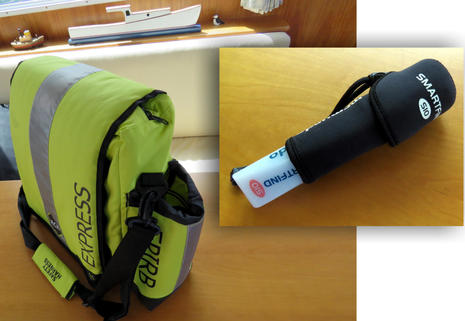 “Geez, I’ve got four of those onboard,” I added, heading forward to grab the ditch bag I’d recently used to organize the various safety devices being long tested. I certainly did not expect any of the beacons to be activated, but when I pulled the McMurdo FastFind S10 out of that big EPIRB pocket, its white translucent end was flashing. It was obviously on, and it was great to find easily-understood Off instructions once the black neoprene cap was pulled back. That’s when the Coasties started grinning.
“Geez, I’ve got four of those onboard,” I added, heading forward to grab the ditch bag I’d recently used to organize the various safety devices being long tested. I certainly did not expect any of the beacons to be activated, but when I pulled the McMurdo FastFind S10 out of that big EPIRB pocket, its white translucent end was flashing. It was obviously on, and it was great to find easily-understood Off instructions once the black neoprene cap was pulled back. That’s when the Coasties started grinning.
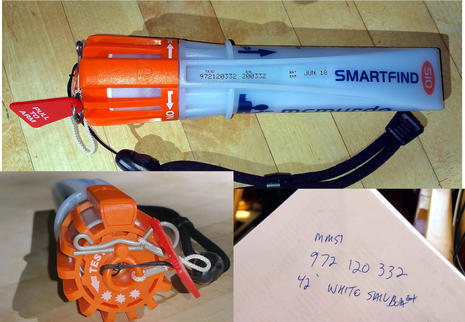 Petty Officer Iaci and Fireman Jansen-Hedrick also got the satisfaction of seeing the S10’s preprogrammed MMSI match up with the one they were looking for. Mission accomplished! And I, too, was happy to head back to my mooring, though that’s where my embarrassment was compounded by learning that the USCG had tried to contact me by cellphone and even by Facebook. I had some explaining to do, at least to myself.
Petty Officer Iaci and Fireman Jansen-Hedrick also got the satisfaction of seeing the S10’s preprogrammed MMSI match up with the one they were looking for. Mission accomplished! And I, too, was happy to head back to my mooring, though that’s where my embarrassment was compounded by learning that the USCG had tried to contact me by cellphone and even by Facebook. I had some explaining to do, at least to myself.
How could a boat as elaborately equipped as Gizmo not see an active AIS MOB alert that was very nearby? How did I miss USCG calls on VHF, by phone, and even via Facebook? And right at the top of my list: How the hell did the well-stowed and untouched S10 turn itself on?
Note the S10’s hand-grenade-like Pull-To-Arm pin above. In fact, this AIS beacon is especially designed for divers who might get separated from their mother vessel. You could activate it while wearing heavy gloves, even mitts, but not accidentally. The spring-loaded orange top easily twists 90 degrees counterclockwise to turn the device OFF (or test it), but it won’t budge clockwise to ON unless the pin is pulled. And it’s never been pulled.
I was planning a WTF email to McMurdo until I mentally connected the magnet symbol molded onto the orange top — it’s saying “I’m a magnetic switch” — to where I’d stowed the ditch bag.
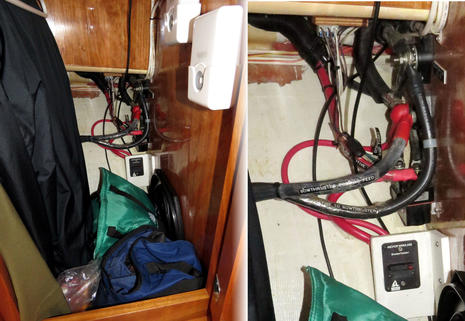 Yup, a couple of weeks ago I stuffed the ditch bag into this forward starboard hanging locker, with the EPIRB pocket up close to those high current bow thruster and windlass cables, as well as the 100 amp circuit breaker. In retrospect I vaguely knew that electromagnetism was possible around such serious 12v power flow — it’s Lenz’s Law, according to Alden — but could there have been enough focused magnetic field to activate the S10?
Yup, a couple of weeks ago I stuffed the ditch bag into this forward starboard hanging locker, with the EPIRB pocket up close to those high current bow thruster and windlass cables, as well as the 100 amp circuit breaker. In retrospect I vaguely knew that electromagnetism was possible around such serious 12v power flow — it’s Lenz’s Law, according to Alden — but could there have been enough focused magnetic field to activate the S10?
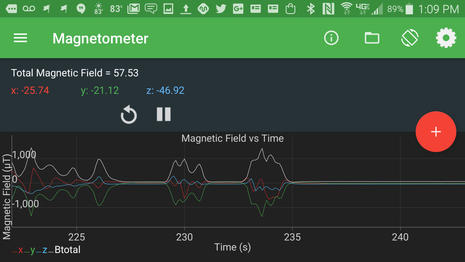 There’s an app for that. Actually, there are umpteen magnetometer apps since most smartphones have the needed sensors, but I quickly settled on the Physics Toolbox Sensor Suite and like it so much I purchased the $2.99 pro version. Yes, this is the part of the story where I got to remember how joyful modern technology often is. Even the free version of the Toolbox app let me accurately measure a total magnetic field with its three vector components and collect the results to a .csv file I could instantly save to the GDrive cloud and later turn into telling graphs on a PC.
There’s an app for that. Actually, there are umpteen magnetometer apps since most smartphones have the needed sensors, but I quickly settled on the Physics Toolbox Sensor Suite and like it so much I purchased the $2.99 pro version. Yes, this is the part of the story where I got to remember how joyful modern technology often is. Even the free version of the Toolbox app let me accurately measure a total magnetic field with its three vector components and collect the results to a .csv file I could instantly save to the GDrive cloud and later turn into telling graphs on a PC.
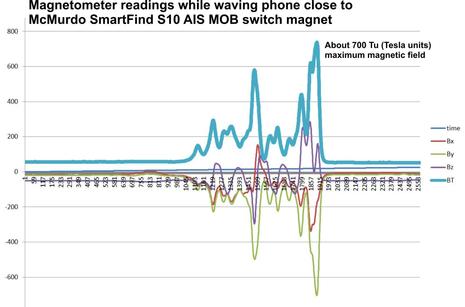 So here’s what my new magnetometer saw when I waved the top of the phone an inch or so from the magnet area of the McMurdo S10 beacon. In other words, that’s the approximate magnetic force that will turn the S10 on if the pin is pulled and the orange top is turned 90 degrees clockwise so the magnet is over the reed switch. Incidentally, I also learned that I could activate the S10 by direct application of a fairly modest magnet to the right spot (in my basement, and very rapidly turned OFF).
So here’s what my new magnetometer saw when I waved the top of the phone an inch or so from the magnet area of the McMurdo S10 beacon. In other words, that’s the approximate magnetic force that will turn the S10 on if the pin is pulled and the orange top is turned 90 degrees clockwise so the magnet is over the reed switch. Incidentally, I also learned that I could activate the S10 by direct application of a fairly modest magnet to the right spot (in my basement, and very rapidly turned OFF).
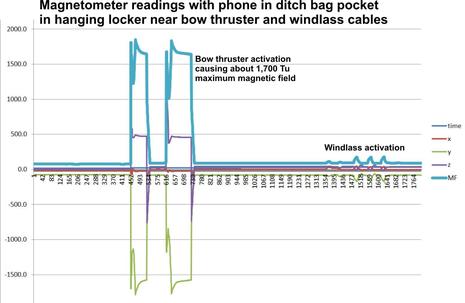 Now here’s what happened magnetically when I put the phone in the ditch bag back in the locker and then ran the thruster and windlass intermittently. My inadvertent mission accomplished? Well, that’s certainly a relatively significant magnetic burst — about 2.5 times what I measured from the S10’s magnet — and I had used the thruster briefly getting off the ramp dock, but that timing did not jibe with what I learned from the USCG command center at Sector Northern New England in South Portland.
Now here’s what happened magnetically when I put the phone in the ditch bag back in the locker and then ran the thruster and windlass intermittently. My inadvertent mission accomplished? Well, that’s certainly a relatively significant magnetic burst — about 2.5 times what I measured from the S10’s magnet — and I had used the thruster briefly getting off the ramp dock, but that timing did not jibe with what I learned from the USCG command center at Sector Northern New England in South Portland.
It was Petty Officer Nicole Van Gieson, an Operations Specialist in the command center, who had called and attempted to contact me via Facebook, which was not necessarily easy since an AIS MOB beacon is not registered to a boat or a person. I figured that the command center saw the beacon tracking with Gizmo on their AIS monitoring screen, but it was more complicated than that. They got their first report of an MOB alert from another vessel just before noon, with an alert position out by Lasell Island. Gizmo was approximately there on the USCG AIS screen, but it took another report or two to gain confidence that this was an unusual MOB apparently swimming across the Bay at 5 to 10 knots right alongside a Duffy 37 linked to me via its AIS MMSI registration (some of which is public).
Van Gieson explained that while the CG always acts on the worst possible scenario — “we strive to have a Coast Guard asset en route within 15 minutes of an initial distress call” — they also try hard to contact boaters possibly in distress to double check. “You would be amazed how many people we have been able to locate safely using Facebook,” she later wrote me on Facebook. In fact, she told me she’d been reading Panbo when I called on Saturday afternoon, and was perhaps gently aware that I might be a guy with too many gadgets, even if she just seemed glad that the incident was resolved.
I’ve heard about this admirable USCG philosophy so many times — from the CG, and from boaters — that I believe it’s service wide. Of course, they’d like to reduce the huge number of false alarms, and they’re rightfully fierce about intentional ones, but they don’t presume bad intentions and they want boaters to contact them, even if they’re not sure their situation has reached distress level. (Which is also why two-way distress messaging has great value.)
At any rate, knowing that my AIS MOB false alert was called in, not actually seen on AIS at the command center, helps explain the DSC/AIS mixup. But I will note that the USCG, and yours truly, could have realized that an MMSI starting with “972” had to be an AIS MOB beacon, as explained well at the CG’s NavCen and often written about on Panbo.
But, wait, if the thruster turned on the S10, why was the first report almost two hours later? My theory: the beacon was only intermittently getting sufficient GPS info in and/or AIS signals out, because it was upside down relative to its desired antenna orientation (plainly marked on the casing) and stuffed in that locker with lots of possible signal obstructions. The theory is somewhat supported by the Marine Traffic screenshot above, which again shows Gizmo’s track but also a single last reference to the S10 beacon 972 MMSI, even though I got it much closer to the Lyman-Morse receiving station.
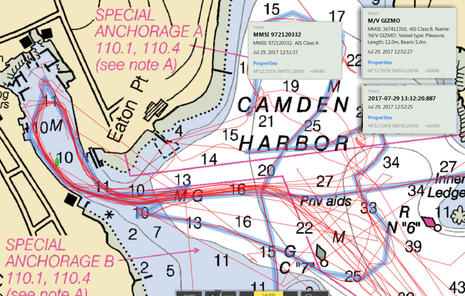 Then I remembered the YDVR log, which led to theory refinement and confirmation. The recorder is on the boat’s secondary N2K network, and it not only captured Gizmo’s own AIS track being received by the Icom M605, but also the boat’s high resolution GPS track and the AIS track of the S10 beacon. That 972 MMSI track starts just after I left the ramp dock shortly before 10am — thruster activation confirmed — and ends at the USCG rendezvous.
Then I remembered the YDVR log, which led to theory refinement and confirmation. The recorder is on the boat’s secondary N2K network, and it not only captured Gizmo’s own AIS track being received by the Icom M605, but also the boat’s high resolution GPS track and the AIS track of the S10 beacon. That 972 MMSI track starts just after I left the ramp dock shortly before 10am — thruster activation confirmed — and ends at the USCG rendezvous.
But the 972 track is also quite consistent over those three hours, indicating that the S10 did have a GPS lock and was transmitting regularly despite its location. I do think that the transmissions were quite muffled — otherwise other boats and the USCG would have been on the case sooner and harder — but the S10 performed pretty darn well in this unplanned test.
McMurdo, incidentally, had never before heard of an accidental magnetic activation of an S10 in its protective pouch, but they were quite interested in this incident and even enthusiastic about its educational aspect. In fact, after looking over my findings, they wrote: “As a result of your detailed analysis of this magnetic field false activation, McMurdo will update our product catalogue to ensure our customers are fully aware of storage and handling best practice.”
So maybe I can count that as an unintended mission accomplished, except that I still haven’t come clean about my failure to see that the S10 was active.
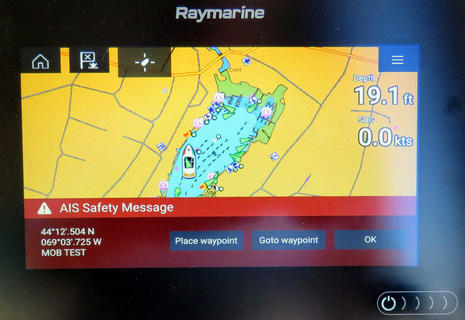 After all, the prime function of an AIS MOB beacon is to alert the boat that it was on before activation, and freaky Gizmo had two AIS receivers and many AIS plotters turned on that day. Plus, as McMurdo justifiably pointed out, one benefit of its new G8 EPIRB with AIS locator is that it could quickly help a boater deal with an accidental activation.
After all, the prime function of an AIS MOB beacon is to alert the boat that it was on before activation, and freaky Gizmo had two AIS receivers and many AIS plotters turned on that day. Plus, as McMurdo justifiably pointed out, one benefit of its new G8 EPIRB with AIS locator is that it could quickly help a boater deal with an accidental activation.
Part one of my answer is easy. Sometimes the always-on Vesper XB8000 AIS transponder does not join Gizmo’s main N2K network when it’s turned on. I think the behavior is fairly peculiar to this network, and I noticed the lack of targets on the three flybridge MFDs it feeds right away, but I didn’t bother to go below and reboot the XB. I could see all the boats fine, anyway, and there was lots of enjoyable socializing going on.
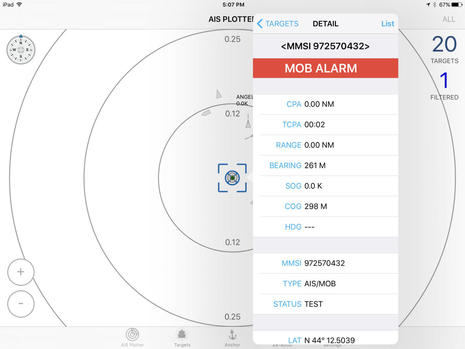 The beautiful day in very familiar waters, the events, and the friends were all part of the bigger distraction issue, but part two of the answer truly makes me cringe. In retrospect, I’m quite sure that I did get an AIS MOB alert, a very loud one, but I shut it down without looking at what it was!
The beautiful day in very familiar waters, the events, and the friends were all part of the bigger distraction issue, but part two of the answer truly makes me cringe. In retrospect, I’m quite sure that I did get an AIS MOB alert, a very loud one, but I shut it down without looking at what it was!
Recall my recent first look at Vesper’s brilliant new smartAIS alarming. I’m so not used to its features that when a loud siren went off shortly after I thrusted Gizmo off the ramp dock, my first guess was the Maretron ALM100s, the only alarm system I’ve encouraged on this potentially way-over-alarmed vessel (until the compelling Vesper update). But there was no sign of alarm on the Maretron displays, and it kept wailing away even when I briefly switched off the N2K network. And, mind you, I was manuevering through a large field of moored yachts from the diminished visibility of the lower helm, while six fresh crew were getting settled or looking over my shoulder for the source of the annoyance.
Finally, I remembered the new Vesper features and had to scramble to open the WatchMate app on the iPad (because I have not yet installed the physical switch I had just recommended). I presumed that it was either an AIS or an anchor drag alarm — both of which I had recently fooled with — and went right to the app page where I could mute the siren. But the Vesper XB8000 can also alarm on an AIS MOB message, again even with the app unopened, and I believe I proved that it is almost foolproof!
So many lessons learned. Hopefully, a lot are already obvious, as I’ve gone on enough, but among the so-far-unmentioned mistakes: I should have had another VHF constantly on channel 16 up on the flybridge, since I often had the Icom CommandMic on the channel used by the parade or race organizers; I should have more than a draft getting-underway checklist of items like rebooting the Vesper (until that glitch is solved); and I should remember that the high incidence of accidents close to home is a real thing. Feel free to add others or compose a list.
Finally, I’d like to apologize to the unknown boaters out on Penobscot Bay whose beautiful July 29th was interrupted by a mysterious and unnecessary AIS MOB alert, and to the USCG who did an exceptional job of handling the incident and yours truly. I believe that the fabulous safety devices we have these days, and the outstanding SAR services they often alert, come with a responsibility to use them properly, including awareness that they are being used.
But, hopefully, this deep analysis of what went wrong will be useful to my fellow boaters, or as the wags at Despair, Inc. note: “It could be that the purpose of your life is only to serve as a warning to others.”


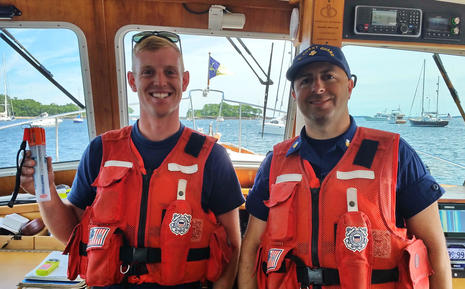
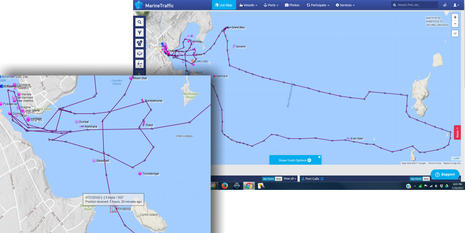

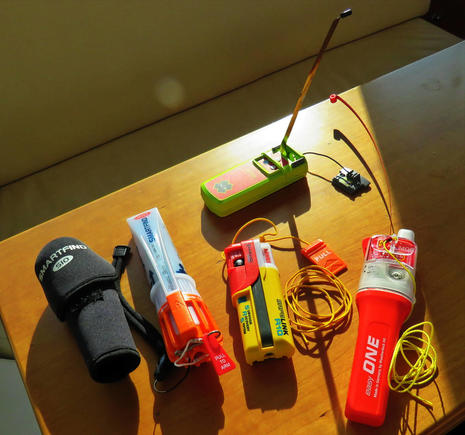


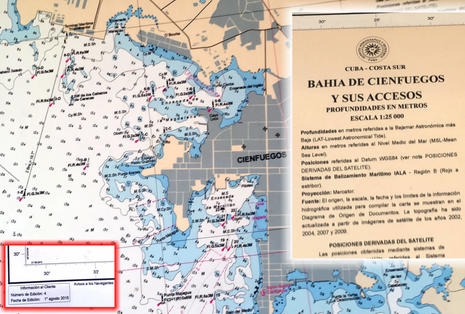






PS It’s occurred to me that I used the bow thruster at least a time or two before this incident with the ditch bag and S10 in the exact same spot. So while I appreciate McMurdo adding a warning in the S10 manual, I think it’s hard to do what I did (without trying).
Also, so far I’m not aware other magnetically switched safety devices. Anyone?
An examination of the various EPIRB units out there might show some switching like that. What better way is there to make a truly waterproof switching method?
Membrane switches, Alden, that’s what I’m seeing lots of. Sometimes they look like buttons but there is still a waterproof membrane between their backside and the actual mechanical switch. They seem common but wouldn’t be good for a diver wearing serious gloves, like the McMurdo S10 is.
It is a good idea to twist power and return wires around each other (as in UTP). That reduces the magnetic field that are generated by current flow. It also, particularly HF/AC ones, it reduces EM radiation and sensitivity to AC/RF.
Thanks, Shane, but you can’t twist together a pair of cables that big. Or at least I’ve never seen it done.
I agree, Ben – the science is correct, but in practice I wouldn’t know how to twist a pair of 2/0 cables around each other and still route them where they need to go. Somebody recommended that to me once for an inverter installation, and my reaction was the same.
Kudos to you, though, for your forthright mea culpa and the extensive research you undertook to troubleshoot and understand the causes. I feel your pain about managing alarms – most of us have had to deal with unexpected false alarms and the clumsy methods to silence, analyze, and reset them. Multiplying that complexity by the number of different systems on Gizmo is almost guaranteed to cause an issue at some point. Personally, I’ve started to lean away from enabling every single feature – especially alarms – that todays electronics are programmed to provide. I think this is another example of technology being included by the engineers because it’s possible, not necessarily because its helpful to the operator. And if you drive over a couple of crab pots (or worse) while your heads-down looking for the alarm, it decidedly UN-helpful.
Hmm, the first and only time I received a DSC alarm on Breeze Pleeze, 2015 I think, I missed out on assisting anyone or the experience of what it looks like because I misinterpreted the unfamiliar alarm as a false problem with my boat and in the urgency to end the noise that was upsetting my guests I reset my electronics before the USCG started broadcasting inquiries on 16.
I wonder how many potential responders to these alerts are similarly confused and therefore unhelpful in an emergency.
Perhaps we could all (or the few of us that listen to 16) use a test alert from the USCG once in awhile to get familiar with the functionality on our boats, much like we have the emergency alerts broadcasted on TV? That little bit of experience would have us respond correctly to silencing the alarm, view the info on our charplotter or radio, and evaluate our position to the alert instinctively.
Ben,
We were sailing to Rockland and heard USCG hailing GIZMO on VHF 16 all least twice an hour for at least 4 hours. I knew it had to be you, given all the GIZMOs aboard! Good lesson for all.
As best as I can recall, at least some of the ACR class 1 and maybe class 2 EPIRBs count on a small magnet in the mounting case to keep the water contact switch, the two little ss buttons an inch or so apart, from activating the EPIRB when it is still in its case if it becomes wet with rain or spray. Not sure that a magnetic field induced from high amp current flow would over ride the effect of the magnet, but maybe. Nikko Buckle in the tech department at ACR would be the man with whom you might wish to speak.
Garry
Ben–your honesty is admirable. Most everything that happened can be forgiven, except the notion that you were underway for several hours without monitoring VHF Marine Band Channel 16. Maintaining a watch on CH-16 is required–and yes, I know many boaters do not do it.
But here’s another aspect: if you were operating in a GMDSS Sea Area A1 (and I am sure you were), you don’t have to keep a radio watch on CH-16 if you have a DSC radio. I bet you have a DSC radio–probably several of them.
Cf.: https://www.navcen.uscg.gov/?pageName=mtWatch
This leads to the next question: if the USCG thought the source of the alert was aboard GIZMO, why didn’t the USCG make a DSC call to your boat using your boat’s registered MMSI? Surely a DSC radio ringing an incoming call would have gotten your attention.
Or, was the USCG making a DSC call to the MMSI of the AIS MOB? In that case, they have to share some of the fault for not being able to reach you via radio.
Thanks for sharing. 1. magnetic switches. I had to relocate an external regulator. I never did figure out what was triggering the magnetic reed switch, but moving it solved the problem. 2. alarms. They all sound the same. Maybe not exactly the same, but they do not convey any useful information beyond that there is an alarm. For something. Somewhere. My story has to do with a CO detector which screams very loudly — when the voltage is too high! Who knew? It was winter, the voltage was fine for the temperature. When alarm is too loud, all you want to do is kill it.
Crazy series of events! Sounds like a once in a lifetime happening.
I have a similar problem with my Vesper XB-8000 not appearing on my N2K network. I’ve almost narrowed it down and can reproduce almost at will, but it’s pretty annoying. Hopefully Vesper is aware, or I can provide some details so they can fix.
We have an inexpensive combined CO / smoke detector – when it alarms there’s the usual loud siren then a recorded voice states whether the alarm is CO or Fire. The alarm alternates between siren and voice message until it is silenced. I mention this because the device is really cheap – an ordinary domestic alarm at an ordinary price. This suggests to me that fitting a similar combined siren + voice message alarm to other devices ought not to be impossible from a cost point of view, and I think it’s going to become essential as the number of potential alarms proliferates.
Thanks, Dan! The test DSC alarm sounds like such a good idea, I fear that the USCG already thought of it and has some reason they can’t do it. But I think I know the right guy to ask, and I have an email out.
Paul, sorry for the hassle but I think it just seemed to go on that long. The USCG command center told me they got the first MOB report at 11:43am, it took a while to correlate the reports with Gizmo’s track, and the incident was all over almost exactly at 1pm.
Jim, you make an interesting point. Petty Officer Van Giesen responded thusly: “We decided not to go that route since we had already blown up the channel 16 and the Station boat was already en route. At that point even if you had answered they still would have confirmed everything in person.”
We are plagued with alarms as well. Last year I started to wire LED indicator lights for every alarm I have onboard. In my opinion, audio alarms are useless while underway because you can’t tell what is alarming. Without a labeled LED indicator light on a panel it’s anybodies guess what might be trying to get your attention. Most alarming electronics allow for this simple addition, however, the most critical alarm, most used, is from my Simrad AP28/AC42 autopilot. The external alarm output on the AC42 only works with a few select alarm categories and the alarms that are sent to the external output are delayed by 30 to 45 seconds a serious oversight by Simrad software engineers.
During a night sail last week in torrential rain and high winds the AIS collision alarm on my Garmin 7612 finally proved to be an important asset. I encountered a number of opposite direction commercial traffic that looked more like a lighthouse in the dark of night then a gigantic tug pushing a massive barge in a restricted channel. I do need to further refine my chartplotters AIS alarm criterion to avoid falls alarms and make this an “always on” feature even during the day.
Every alarm must have both an audio and a labelled visual indicator or it’s useless.
Looking at the picture, Ben, I think it’s likely the culprit wasn’t the wires themselves, it was probably the solenoid switch for the thruster – that puppy is likely to have a MASSIVE magnetic signature, MUCH higher than the wiring.
OTOH, that also means you could surround it with steel/iron and shield that field.. 🙂
Still in Exeter with my Dad – maybe next week 😉
Good point. Twisting the power cables is a good thing, but it is not the most important thing. To reduce the magnetic field the most important thing is to have the positive and negative cables side by side. That way, the fields cancel out at a distance. In a solenoid, the cable is repeatedly looped, probably wound around a core, so all the cables add cumulatively to build a magnetic field.
Nice try, gents, but the circuit breaker is for the windlass, represented on the magnetometer graph by the little chop after the thruster tsunami. However, the top of the phone where the sensor is was up closer to thruster cables, just as the top of the S10 was. Also those cables are 4/0 gauge and when I just tried to watch the Victron shunt output as I ran the thruster it seemed to read 600 amps. Is that possible?
Dan,
I had a similar experience with a DSC alarm. The first time I heard one was during pouring rain, with limited visibility. I had my hands full navigating and initially could not figure out what the alarm was for. Finally I realized what it was, and was able to determine that I was quite far from the boat in distress and closer boats were already responding.
It reminds me of something that happened to me many years ago, while flying a Lear-36. An alarm went off and the other pilot and I went nuts try to figure out what it was for. After a few tense moments I realized it was the pager (remember those?) that I was wearing on my belt.
CH16 issues aside … the XB8000 requires periodic reboot? Do your MFDs detect and alarm when XB8000 comms are lost? This seems really dangerous, particularly for Maine fog.
What’s Vesper got to say about all that?
Sparky, it only happens when I first power up the NMEA 2000 network, and then only occasionally. The Vesper XB8000 does fall off the network once it’s on it (though I do not think any MFD would alarm me if it did, like they do with GPS and Heading sensors).
I have told Vesper about this and apparently it’s not a common problem. But notice from the comment above that Steve Mitchell has also experienced the problem. Time for both of us to bug Vesper!
(And the cool thing is that if and when Vesper comes up with a fix, uploading a firmware update to the XB8000 couldn’t be easier with the latest iPad app.)
Sparky and Ben,
I have the same issue with my XB8000, (latest firmware installed). If I keep the unit on for 24 hours I sometime see the XB8000 with the green light on, but I have no AIS targets on the N2K network – Nothing showing on either Coastal Explorer or the Garmin 7612. A simple reboot of the Vesper fixes this for another 24 hours. I sent an email to Vesper about this and the conclusion was that the dropout was because I had a high vswr. This is true to some extent. My vswr on the Vesper app shows one blue dot less then 3:1. In the latest firmware this is classified as “good”, however tech support said it needs to come down and the dropout problem will go away. Is the XB8000 dropping off the network in order to protect itself from a high vswr ? My entire VHF/AIS coax is new LMR400 with factory installed connector at the masthead but with my installed pl259 at the base. Installing these connectors involves luck and some black magic to get them right. I also have the Vesper splitter in the system. One more thing, there is no alarm on either the 7612 or Coastal Explorer when the XB8000 drops off the N2K network. You just have to notice that your AIS targets are gone.
I am pretty sure Vesper is aware of the issue, or at least found out about it from both Ben and I and others. I just clicked into the latest firmware details for the XB-8000, which I have not installed yet and there is this bullet point:
After a NMEA2000 bus power cycle XB-8000 reconnects more robustly
So I suspect they fixed something, which is good. I hate having to power cycle mine. I get a secondary feed of AIS data from my B&G VHF radio onto the N2K network, so at least MFDs and such see other AIS targets, and I know my XB is still transmitting my location as I’ve verified it, but it would still be nice for it to not disappear 🙂
https://support.vespermarine.com/hc/en-us/articles/115000627163-WatchMate-XB-8000-deckWatch-smartAIS-Update-Available
A portable handheld or small compass is a good device to use to find out if a magnetic field is present. The needle will move. It is best to try this technique with devices switched on and off. For example windshield wipers will exhibit a magnetic field when turned on.
Look at solenoids, pumps, relays, d.c. motors, fans etc.
Hi Ben,
600 amps @ 12V = 7200 watts = 9.5 HP — probably not out of line for a thruster. This is why they’re using 4/0 wire!
It looks like I’ll be in Exeter for a while longer 🙁
Ben, any reply back? “Thanks, Dan! The test DSC alarm sounds like such a good idea, I fear that the USCG already thought of it and has some reason they can’t do it. But I think I know the right guy to ask, and I have an email out.”
Years back I commissioned a new boat with two electric toilets – they both flushed beautifully whenever the SSB radio microphone was keyed. A little shielded twisted pair control wire to the toilet buttons fixed that.
Also, ref that problem with the XB-8000 not appearing on the bus, I reported it to Vesper in late 2015 / early 2016, and they said it wasn’t their problem (!). I guess a few other people have chipped in and it has got some attention. Be glad when I don’t have to reboot it all the time.
I feel your pain, Ben! a couple of years ago we hit a small wave and the autopilot went nuts – after some investigation – the fluxgate compass was mounted under the nav station next to a small bailout bag with the ships papers. but that year I had thrown a flashlite into the side pocket of the bag – the shake a light kind! when we bounced on the wave, it fell over and put it’s large magnet next to the compass.
Also, some of my inflatable life jackets have strobe lights with a magnetic test switch – placing them near a large magnetic field could deplete the battery in the light.
Seems that audio alarms should be augmented somehow, along with the suggested visual representation, how about a short voice annunciation to go with it? (and perhaps a nice little side business for people providing alternate voices, bit like the sat nav, maybe?)
Thanks Ben for the instructional rehash of the incident. I think that the human/digital interface is an area that still requires lots of work, and is as much art as science. The other day I was anchored in a favorite shallow harbor when another boat came in accompanied by a continuous series of nearly earsplitting warning beeps (even from my rather distant location). I’m guessing it was their depth alarm going crazy, but I thought to myself who would want that thing blaring while trying to find a safe anchoring spot in a crowded harbor? I know I have turned off the VHF on some days while underway due to the constant blaring of the DSC alarm for something going on that was obviously a false alarm. I think we are all in some danger due to the “crying wolf” problem with all these alarm systems. Just imagine if you had really been sinking, in a fog, and in real need of help. Would they have been able to find you in time?
Two stories!
1) I had friend who frustrated with a persistent alarm that he had trouble silencing finally got it turned off (at the time he didn’t observe anything “wrong”). Later that evening I received a panicked visit – his boat was sinking and he needed help to potentially evacuate it and shut down the engine (most of the engine was underwater – that diesel kept on running with just a few inches out of the water – thankfully including air intake – but ability to turn off using deck switches).
Turned out he had cracked the stern of his boat backing into a dock, and then turned off the bilge alarm and pump. How could that happen? A similar set of assumptions / crowded boat / lack of familiarity with the alarm in question.
2) Back when you couldn’t turn off DSC VHF alarms easily I finally turned off my entire radio one night as someone idiot had their button pressed in a bag somewhere. I was operating commercially at the time and not being able to use the radio at night was a monster hassle. So making the alarms unsilencible has its own risks.
Ben, Well I imagine now for sure that all your neighbors know and love you including the U.S. Coast Guard! With a vessel named Gizmo and way smart salty geeky mad scientist captain at the helm it could have made a pretty good reality tv show! LOL! Like you said though….perhaps the purpose of your life may be to warn others! Kidding aside.. I believe you do that job better than anyone in the business Ben! Thank you.
Glad only your pride was bumped a bit and not you! thx for sharing.
John
A few years ago the local guy in charge of the local EPIRB/ELT/PLB radio location volunteers caused a false alarm himself when he threw an EPIRB with a magnetic switch into a box with a magnet-mount antenna. He’s the guy who spends most of the time tracking down false alarms.
But really it seems magnetic switches = bad idea.
Ben, Steve,
Thanks for bringing the NMEA 2000 issue to our attention. We have been able to isolate the problem, and it seems to periodically occur when the XB-8000 or WatchMate Vision are left on for long periods of time with no N2K bus power. When the problem occurs, the next time the N2K bus is powered on the unit may fail to join the network. The good news is a fix is in place, is under beta testing, and should be ready for roll out via our mobile apps update channel in the next week or so.
To clarify, we are yet to see a case where the XB-8000 or WatchMate Vision spontaneously removes itself from the N2K network. There have been some ideas around creating an alert around this kind of scenario though i.e. when the transponder leaves the network, and it is something we have been mulling over. This will lead to an alarm every time you power off your N2K network so may provide more annoyance than value, more feedback on this is welcome.
VSWR reporting within the XB-8000 and WatchMate Vision is not tied in any way to N2K functionality. If you are having issues related to VSWR or N2K I encourage you to contact our support team ([email protected]) and we will do our best to work with you in diagnosing and resolving the issue.
Carl
Vesper Marine
Carl,
Thank you for your post explaining this lost AIS target issue. I have been working with Tom at Vesper thinking the issue was my VSWR, but now I realize my problem is as you describe and is the same as Ben and Steve have. My XB8000 is on a separate breaker from all other electronics. At night I shut down all electronics which includes the N2K network to save power, but leave the XB8000 on. In the morning when getting underway I turn on electronics with N2K and eventually realize I have no AIS on the chartplotter or computer. I look forward to the firmware fix you have in the works.
I am in favor of an alarm to indicate that the XB8000 has been shut down and all AIS targets lost, however, I’m not sure this should be Vespers responsibility. In my opinion, it is the software or chartplotters that use the services of the XB8000 that need to alarm. In addition, that alarm should be easily silenced.
Thanks again for explaining the issue.
Rich Cassano, S/V Gray Eagle
A bit OT, but definitely related – on Saturday, while entering the Connecticut River just North of the I95 bridge, my autopilot executed a hard left turn just as I cleared the pylon base. I initially ascribed the disturbance to the usual current swirls downstream of the bridge pier, but then I noticed the large high-tension line overhead, just North of the bridge.
When we left the river on Monday, I disengaged the autopilot and watched the heading readout closely – sure enough, starting with the line overhead and not ending until we were well clear of the bridge on the South side, the heading varied as much as 20 degrees from the actual course line! I’m speculating that the HT line is inducing currents in the bridge’s metal structure, causing a greater magnetic effect at water level than one might otherwise experience. We’ve been under lots of overhead power lines before, but never had a noticable effect like this one!
Speaking of alarms, here’s a different option. I built a little Arduino engine alarm that uses Morse code… “O” for oil pressure, “W” for water temperature and so forth. It’s working out very well. I posted the details and code for anyone interested in building one themselves. It’s here: http://www.twoatsea.com/arduino-exhaust-temperature-sensor/